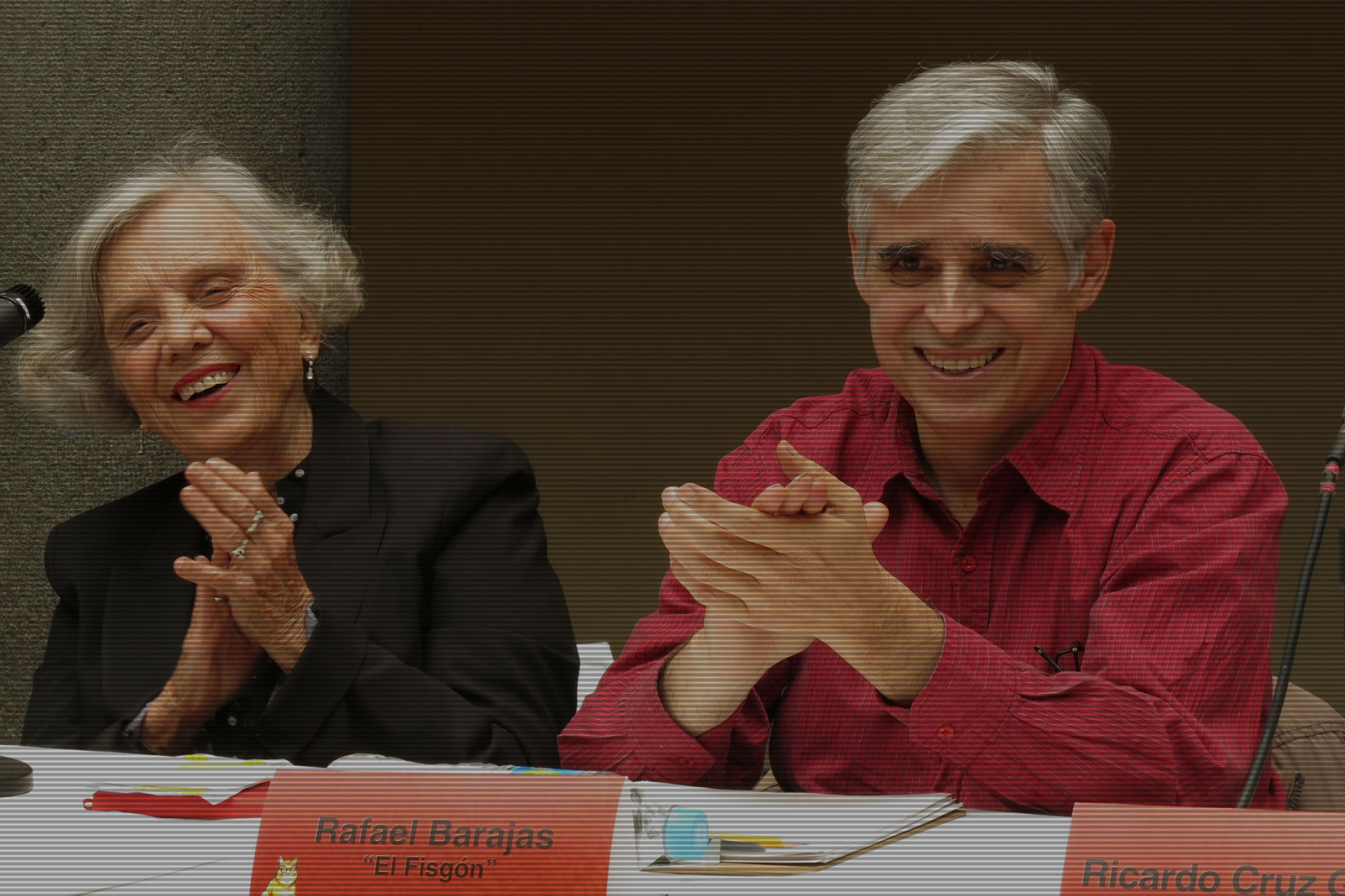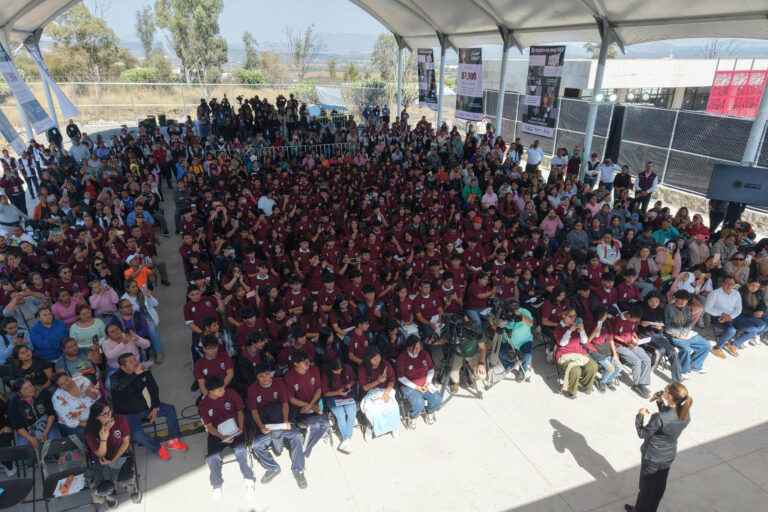LAUGHING ALL THE WAY TO THE BARRICADES
ICE agents grabbed a kid out of an elementary school classroom and dragged him off in my rural community, on an island far from any border, in the deep blue state of Hawaii. Horrifying.
This is no laughing matter, right? But as cartoonist par excellence Rafael Barajas, better known as El Fisgón, tells us, laughter is a natural response, a way of dealing with pain, of breaking it down into bite-sized pieces. The cartoon below asks us: would you ever have imagined that the mention of frozen water would scare the bejesus out of us? Isn’t it stupid that a 10-year-old school kid could be arrested as a criminal? Are tough guys like Trump and his ICE agents scared of a child? It’s ridiculous! And “ridiculous” means that it’s laughable.

Laughter is a therapy. When we laugh, our burden feels lighter, and the impossible seems possible. Recently, a friend of mine was diagnosed with cancer. I didn’t send her thoughts and prayers. I sent her a joke a day.
But there’s more. Laughter is a wonderful virus — it’s contagious. When someone near you laughs, you can’t help laughing too. Political cartoonists are revolutionaries, using humor to purposely incite resistance. When we laugh together, laughter becomes excitement; it makes us brave; it propels us to action.
On to the barricades! Hahaha!

Rafael Barajas Durán, better known as El Fisgón, is a Mexican cartoonist and illustrator. He has co-directed satirical magazines such as El Chahuistle and El Chamuco y los hijos del Averno and is a regular contributor to La Jornada. He also heads Morena’s National Institute of Political Formation.
What is the role of humor in politics?

Freud once said people have three responses to extreme situations: violence, sex — and humor. And John Lennon remarked that the people who are most oppressed have the best sense of humor. That makes Mexico a superpower of humor! Humor is a very sophisticated response to oppression. It’s a tool of resistance.
Mexico has a long tradition of political humor expressed, among other means, through drawing and cartoon magazines.
It first arrived in Mexico from a French magazine of caricatures in the mid-19th century, but we developed it uniquely here.
In the 19th century, cartoon magazines were central to Mexican political debate. They were the vanguard of the liberals’ debate against conservatives, a bastion of resistance during the French Intervention and a vital forum for political debate during the restored Republic.

The main defense of radical liberals and socialists during the long dictatorship of Porfirio Díaz was the cartoon magazine El Hijo de Ahuizote, or, in English, The Son of Ahuizote. The ahuizotl is a mythical people-eating creature from Aztec times, said to have lured humans to their deaths. It can be argued that this magazine was a significant element in preparing the ground for the Mexican Revolution of the early 20th century. As a strategy of resistance, Díaz’s opponents used mockery and satire — caricaturing terrifying oppressors made them less all-powerful and invincible.
Images allow us to move from abstract to concrete thought, so cartoons are a useful teaching tool. At Chamuco TV — chamuco is someone devilish, mischievous — graphics are important. I don’t just talk, I draw.
We have a saying in English: “It only hurts when I laugh!” That describes your humor. “Haha! Ouch!” But humor can range from lighthearted to cruel. What’s the line you can’t cross?
I bet most of the jokes you know are based on painful situations. See if you can think of ones that aren’t. In Mexico City, after the 1995 earthquake, two things sprouted. Solidarity — and jokes! One circulating joke — some children were playing hide-and-seek in a collapsed area, and one said, “1, 2, 3! I spy my cousin who’s under that pillar!”
Laughing at misfortune gives us relief, but cartooning is an ethical activity. We must show respect for the people. When making cartoons, we mock the oppressor, but not the oppressed. We mock the corrupt, but not their victims.
The powerful don’t like being mocked. Throughout our lives, cartoonists at El Chamuco have received threats, and currently, at Chamuco TV, we’ve been sued more than once by the National Action Party (PAN) and others from the right wing. You know you’ve hit a nerve when they try to shut you up!
AMLO was a master at using humor. Claudia has a very different style, doesn’t she?
AMLO frequently used humor to confront his opponents and dismantle the multiple smear campaigns mounted against him. The big issue for him during the neoliberal era was government corruption. All of Mexico remembers a 2018 presidential debate, when the right-wing PAN candidate, Ricardo Anaya, took the microphone and approached AMLO in a threatening manner. AMLO stepped back, crossed his arms over his chest in a protective gesture, and said, “Oh, I’d better watch my wallet!”

His morning press conferences were political theater, and one element was humor. Claudia is calmer, but her sense of humor is sharp. Trump capriciously decided to rename the Gulf of Mexico as the Gulf of America. The next day, instead of being indignant, Claudia showed an ancient map on which, above what is now the United States, was written: “América Mexicana,” and she proposed that, for historical reasons, North America be renamed Mexican America. “That sounds nice, no?” She made Trump look ridiculous.
Humor is a mechanism of resistance, both personal and social. And when used extensively, it becomes a culture. Authoritarian leaders instill fear. The task of resistance, then, is to overcome fear. El Hijo del Ahuizotl taught us that the first step to overthrowing a tyranny is to belittle the tyrants.
You say cartoons are an educational tool. So, is political education your personal goal? Is that why you head Morena’s National Institute for Political Training?
The 4th transformation wouldn’t have happened without political education. In fact, that’s the origin of any political transformation. Preceding the American, French, Mexican and Haitian revolutions of the late 18th and early 19th centuries — which replaced monarchies with republican forms of government — were critical debates. They first took place in Freemasonry circles.
Great discussions also preceded the liberal revolutions occurring between 1830 and 1848. In the late 19th and early 20th centuries, Marxists and anarchists transformed people’s consciousness primarily through study circles. Every process of transformation must first achieve the “massification” of a new consciousness, a revolution of consciousness. This massification always begins in small groups and spreads unevenly until it becomes unstoppable.
In Morena we have a saying, “Sin formación, no hay transformación.” “Without education, there is no transformation.” It sounds better in Spanish!
In the new political context of Trump acting like Tyrannosaurus Rex —the tyrant king! — what can US progressives do to defend the 4th Transformation and Mexican sovereignty?

So far, Claudia has defended Mexico with great poise against Trump’s attacks. However, the threat’s not over, and we need two things from our US comrades. One is solidarity. The slogan of the French revolution was liberté, égalité, fraternité, freedom, equality — and fraternity — between peoples. When ICE comes for our brothers and sisters, what will we do but defend them? Across the globe, capital creates economic ties between companies, but we, the people, organize ourselves by building bonds of trust. Migrants must know their allies support them.
Mexico has always been a land of asylum. During the McCarthy era of anti-communist hysteria in the US, many Americans on police lists or blacklists came to Mexico, where they found protection, friendship and work. That is the kind of solidarity that Mexican migrants working in the United States today require.
Second, we need massive protests within the United States against Trump, and we’ve already seen many. We see a lot of humor in these demonstrations. That means the resistance is moving forward!
-
The Poor as Instruments, Not Allies
Welfare programs with political aims are not the same as forging political alliances with the impoverished population created by voracious neoliberal capitalism.
-
Florida, the Race for the Presidency & Opaque Capital
Contemporary Florida is the distorted and advanced mirror of a new form of global governance, where money laundering has not only been tolerated, but institutionalized & updated for the digital age, fed by a murky river flowing from the Global South.
-
People’s Mañanera December 22
President Sheinbaum’s daily press conference, with comments on economic achievements, Sonora development plan, extortion of immigrants, Baja California Sur dam, water treaty with US, nepotism loopholes, and García Luna.




